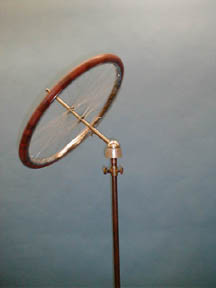Demos: 1Q-30 Bicycle Wheel Gyroscope

A bicycle wheel is fitted with a long axle, one end of which has a ball. The ball can be seated in a socket which is free to rotate, placed on a heavy stand. The wheel is set spinning and the ball end set in the socket. By placing the wheel in the socket such that the axle is at an angle or horizontal, the bicycle wheel precesses, the direction being determined by the sense of the rotation of the wheel. This illustrates the relationship between the torque and the change in the angular momentum vector.
In the diagram at the right, the wheel is shown spinning in the clockwise direction, so that using the right-hand-rule, the angular velocity and the angular momentum vectors are as shown. Using the right-hand-rule again, the vector torque is perpendicular to L and in the direction indicated. This is also the direction of the change in the angular momentum, so that the precession is in the counterclockwise direction (looking down).
Directions: You can spin the bicycle wheel by hand and achieve sufficient rotation for several precessions, but you can also use the spinning motor supplied for faster rotations. When the wheel is up to speed, place the ball in the socket so that the axle is horizontal (or close to it). Release the axle and let it precess. To show the relationship of the change in angular momentum to the momentum itself, repeat the demo with the wheel rotating in the opposite direction. The precession will be the other way.
Suggestions for Presentation: First, hold the wheel in your hands, supporting both ends of the axle (wheel not spinning). Ask what will happen if you simply let one end go. Students will predict correctly that the wheel will fall. Then set the wheel spinning and ask again what will happen. Show the results. Now focus carefully on the vectors involved.
While wheel is precessing horizontally, use a stick and carefully push against the free end, horizontally. Depending on whether you push in the direction of the precession or opposite to it, the free end will start to move up or down, because the torque r x F is up or down.
Applications: A most interesting application is to the turning of a motorcycle. When the cyclist begins a right turn, he momentarily twists the handlebars to the LEFT! This creates a torque that causes the wheels to “lay down” toward the right. When this happens, the gravitational torque causes the wheel to precess to the right, in the direction of the turn.
Last Updated: Nov 30, 2023 11:25 AM